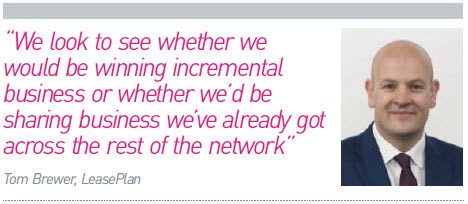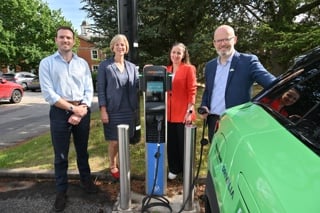Broker partnerships are playing an important role in driving volumes in the SME and personal leasing space for major FN50 companies.
Despite the average number of broker partners falling this year (from 31 to 24) there has been a two percentage point rise in the amount of business that leasing companies are putting through their broker network. The average percentage is now 15%, up from 13% this time last year.
Steve Cocks, director of Lex Autolease’s broker division, which has the biggest broker network with 125 partners, says: “The broker channel has been a major contributor to our fleet growth in recent years and it remains a key pillar in our plans for sustainable growth in both business and personal contract hire (PCH).”
PCH has been growing faster than business leasing with the latest leasing survey from the British Vehicle Rental and Leasing Association (BVRLA), published in September, revealing that the PCH sector had grown by 36% year-on-year while business fleet leasing had grown 7.6% over the same period.
Personal leasing is proving more popular due to a change in people’s buying habits as retail customers are choosing to lease rather than buy.
Providers also suggest that attractive PCH deals have tempted drivers to opt out of company car schemes and take a cash allowance instead to fund their own vehicle.
While the number of broker partners are relatively static for some leasing companies, the UK’s second biggest leasing company, LeasePlan, which has been in the broker market for more than 30 years through its Network brand, has reduced its partners from 97 last year to 85. 
Tom Brewer, Network brand director, says this is down to a number of factors: consolidation in the broker market (for example, Fleet Alliance acquired Neva Consultants at the start of this year), brokers exiting the market and LeasePlan parting company with brokers who don’t meet their volume criteria (they must do at least 100 units per year with LeasePlan).
LeasePlan insists its brokers are BVRLA members and have the correct Financial Conduct Authority (FCA) permissions.
“We would do some due diligence on the brokers as well in terms of the way they’re advertising their products,” Brewer says. “We also look at brokers’ business models in terms of what segments they serve. Do they specialise in any particular areas? Does that provide an opportunity we don’t have today? We look to see whether we would effectively be winning incremental business or whether we’d be sharing business we’ve already got.”
Like LeasePlan, Hitachi Capital Vehicle Solutions stipulates that the brokers it works with are registered with the BVRLA and the FCA. It also requires them to have a data protection licence, trade out of office premises and have a minimum of five employees. It has the second biggest network (100 partners, down from 101 last year) but it has a core network of 60 brokers. It re-entered the broker market in 2013, having withdrawn in 2008 during the credit crunch.
“At the time, the broker market was pretty unmanaged,” says Chris Swallow, head of Hitachi’s broker division. “There was something like 3,000 brokers and there was very little legislation. I think the whole industry got a bit burnt because of it.”
Today there are fewer brokers in the market – the BVRLA currently has 313 broker members – but they are much bigger and “are quite sophisticated digital businesses”, with, in some cases, 70-100 employees whereas five years ago they might have had fewer than 15, according to Brewer.
“They’ve matured a great deal as they’ve scaled up, which for us is a win-win,” Swallow says. “Compliance and regulation have been good for the broker market. We have a greater level of assurance around the way our financial products are sold by brokers.”
Re-entering the market
Regulation and compliance gave Hitachi “comfort” to re-enter the broker market, according to Swallow, who was appointed in February 2013, having previously run ALD Automotive’s broker division. Hitachi now does 8,000 to 10,000 units a year through its broker channel.
Alphabet entered the broker market in 2014 with its Partner network. It now has 46 broker partners with a portfolio of 20,000 vehicles, although it balances that with its own direct SME operation which funds more than 30,000 units.
Nick Brownrigg, Alphabet GB CEO, says: “We only work with brokers that have a small number of leasing partners, not a panel approach.”
He is critical of leasing companies that have moved too heavily into the broker market, foregoing the cost of their own investment in the SME channel.
“While it’s your product, it’s not your customer,” he says. “For the right customer, there is a justification for going direct and we have a proven model.”
Of the smaller leasing companies, Agility Fleet, which sits at 39 in the FN50, has the biggest broker network with 22 partners.
“In the past, brokers would come to us because they couldn’t get a direct funding route elsewhere. Now we’re a bit more selective over which brokers we work with,” says Agility’s managing director Keith Townsend.
While major leasing companies will fund both personal and business leasing for brokers, Agility only funds business-to- business through the broker sector.
“That’s a decision we took some years ago and we’re sticking to it for the time being,” says Townsend.
“The broker-introduced business does one of two things for us. It either gives us volume, which has low margin or it gives us good margin, but more complicated business.” he says.
 Agility targets fleets with fewer than 500 vehicles and, in particular, sub-150 fleets, so the broker customer base complements its own.
Agility targets fleets with fewer than 500 vehicles and, in particular, sub-150 fleets, so the broker customer base complements its own.
For major leasing companies, brokers can be a way to access parts of the market they might not otherwise have a presence in or to quickly grow their share in those markets – not only in SME and personal leasing but in commercial vehicles and specialist vehicles.
But it isn’t just about growing volume.
Brewer says that LeasePlan is making a transition from “volume to value”.
“From a LeasePlan strategic perspective we have been more selective around the type of business we want to write through this particular channel,” he says.
“We’ve generally looked towards three- and four-year contracts and away from two-year ones and we’ve looked to grow the number of maintained vehicles we write as opposed to non-maintained, from a profitability perspective.”
This has been resulted in a slight reduction in the amount of business LeasePlan puts through its broker channel.
There are still a number of leasing companies outside the top 10 of the FN50 who have fewer than 10 broker partners. Some have just one broker partner.
Of the major leasing companies, Zenith is a noticeable absence from the broker sector but managing director Ian Hughes says this is a strategic decision.
“We don’t currently have a retail PCH offering and don’t work with SMEs and therefore have no need to have any broker relationships,” he explains. “Our core focus is purely on blue-chip companies.”
For those that do choose to operate in the broker market, further growth is expected in personal and SME leasing. However, like leasing companies, brokers face a range of challenges, including compliance with the forthcoming General Data Protection Regulation (GDPR) and uncertainty surrounding the impact of the Brexit vote.
Smaller brokers may struggle to survive and those that do will need to innovate. There is also likely to be further consolidation and, therefore, fewer broker partners.




















Login to comment
Comments
No comments have been made yet.